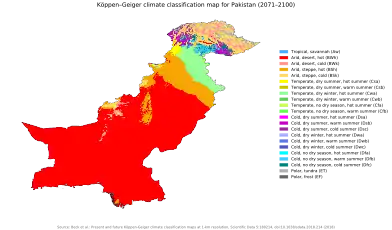Climate change in Pakistan
Climate change in Pakistan is expected to cause wide-ranging effects on the environment and people in Pakistan. As a result of ongoing climate change, the climate of Pakistan has become increasingly volatile over the past several decades; this trend is expected to continue into the future. In addition to increased heat, drought and extreme weather conditions in some parts of the country, the melting of glaciers in the Himalayas threatens many of the most important rivers of Pakistan. Between 1999 and 2018, Pakistan was ranked the 5th worst affected country in terms of extreme climate caused by climate change.[1]
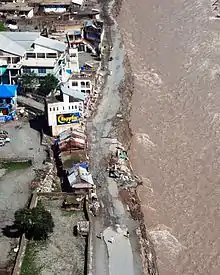
Pakistan contributes little to global greenhouse gas (GHG) emissions at about less than 1%,[2] yet it is very vulnerable to the effects of climate change. Pakistan's lower technical and financial capacity to adapt to the adverse impacts of climate change worsen its vulnerability.[3] Food and water security, as well as large displacement of populations are major threats faced by the country.[4] Pakistan's agriculture-dependent economy is especially susceptible to increasing irregularity and uncertainty over climatic conditions. Like many other South Asian nations, Pakistan is faced by high risk due to climate change effects.[5]
Background

The poverty rate of Pakistan, when estimated at $2 per day purchasing power parity, exceeds 50% of the total population with stark provincial disparities.This high prevalence of poverty, coupled with the lack of and access to resources, places the country in the low human development category, ranked 146 out of 187 countries, well below the average human development index value compared to other South Asian countries.[5][6]
While the effects of climate change are highly region-specific, its can be said with a high degree of confidence that mean surface temperatures are rising and extreme weather events will increase over time. These changes will disrupt expected environmental processes and human activity. The factors thought to affect climate change can exhibit variability too. Chaotic and periodic variations have been observed over different regions of the Earth and varying spans of time. However, it is virtually certain that human activity is changing the climate of the Earth.[7]
The Intergovernmental Panel on Climate Change (IPCC) Fifth Assessment Report (AR5) for the Asia region noted that the sensitivity of agriculture-dependent economies (such as Pakistan) toward climate change arises from their distinct geography, demographic trends, socioeconomic factors, and lack of adaptive capacity that when taken together, determine the climate change vulnerability profile of the country.[5][8]
The climate change projections of the AR5 for South Asia as a whole show that warming is likely to be above the global mean and climate change will impact the melting rate of glaciers and precipitation patterns for the region, particularly affecting the timing and strength of the monsoon rainfall. Consequently, this will significantly impact the productivity and efficiency of water-dependent sectors such as agriculture and energy.[5]
General future projections for Pakistan are expected to be:
- Pakistan’s projected temperature increase is expected to be higher than the global average.
- Projected temperature increase in northern parts is expected to be higher than the southern parts of the country.
- The frequency of hot days and hot nights is expected to increase significantly.
- Pakistan’s rainfall projections do not indicate any systematic changing trends.
- Major crop yields such as of wheat and rice are expected to decrease significantly.
- Water availability per capita is projected to decrease to an alarming level.
- An increasing trend in the rainfall over the Upper Indus Basin and decreasing trend in the Lower Indus Basin.[5]
Greenhouse gas emissions
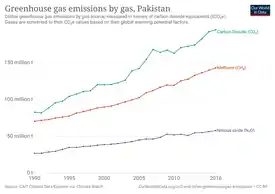
Climate Change Mitigation Pakistan's greenhouse gas (GHG) emissions are low compared to most countries. Pakistan ranks 140th in per capita GHG emissions out of 191 ranked countries according to the The Global Economy report on per capita GHG levels of countries.[9] According to the national GHG inventory of Pakistan for the year 2011–2012, its total GHG emissions stood at 369 million tons of carbon dioxide equivalent (MtCO2e).[5] Within economic sectors, 45.9% of the share of belonged to the energy sector, 44.8% of the share to agriculture and livestock sector, 3.9% of the share to industrial processes, and 2.6% of the share to land use change for forestry sector.[5][10]
According to a preliminary projection, the GHG emissions levels for Pakistan are expected to increase many times in the coming decades. This is based on the assumption that the GHG emissions intensity for the above-indicated five main sectors will remain similar to previous levels. Thus, the projected total GHG emissions of Pakistan - in line with the government’s economic growth strategy - will be more than double by 2020 ( as compared to the emissions in 2008), and increase by around 14 times by 2050.[5]
As such, the most important targets for mitigation efforts focused on reduction of GHG emissions are the energy and agriculture sectors. In the energy sector, integration of climate change and energy policy objectives is particularly important as today's investment such as in the Thar coalfield will “lock in” the infrastructure, fuel and technologies to be used for decades to come. Similarly, the building and transport infrastructure put in place today should meet the design needs of the future. Therefore, energy efficiency requirements in building codes and long-term transport planning will prove important.[11]
According to research led by Dr. Adil Najam at the Lahore University of Management Sciences, by 2040 the cost of climate change to agriculture in Pakistan is likely to be up to 7% of productivity but that good climate adaptation practices could result in a net productivity gain of up to 40%.
Observed and Expected Effects
The National Climate Change Policy (NCCP) of 2012, framed by the Government of Pakistan as the guiding policy document for the country on climate change, acknowledges the growing risk of future extreme natural hazards due to climate change. It further provides a picture of the vulnerabilities faced by individual sectors, ecological regions and socioeconomic classes.[5] The major climate change threats identified in the report include:
- Considerable increase in the frequency and intensity of extreme weather events.
- Increased siltation of major dams caused by more frequent and intense floods;
- Rising temperatures resulting in enhanced heat and water-stressed conditions, particularly in arid and semi-arid regions, leading to reduced agricultural productivity;
- Further decrease in the already scanty forest cover, from too rapid change in climatic conditions to allow natural migration of adversely affected plant species;
- Increased intrusion of saline water in the Indus delta, adversely affecting coastal agriculture, mangroves and the breeding grounds of fish;
- Threat to coastal areas due to projected sea level rise and increased cyclonic activity due to higher sea surface temperatures;
- Increased stress between upper riparian and lower riparian regions in relation to sharing of water resources;
- Increased health risks and climate change induced migration.[5][12]
Extreme weather events
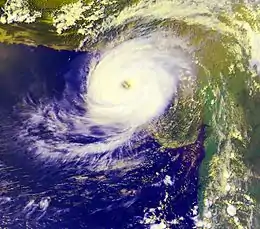
Extreme weather, such as cyclones or intense monsoons are likely to increase in Pakistan because of increased sea and atmospheric temperature.[13] Government projections, highlight considerable increase in the frequency and intensity of extreme weather events, coupled with erratic monsoon rains causing frequent and intense floods and droughts.[5][12] For example, between 1998-2018 Pakistan reported more than 150 extreme weather events.[14]
Increasing Temperatures
A significant increase of 0.57°C in the annual mean temperature has been recorded for Pakistan from 1901 to 2000. While this mean change was less than the mean of the South Asian region, a more accelerated trend of warming of 0.47°C was 1961 to 2007 indicating an increase in the rate of change of mean temperature. As with all climate and weather effects, the phenomena is region-specific where some regions indicate slightly lower averages. An overall increase in extreme temperatures is very likely and will significantly alter expected climate patterns. Further, most regions report increasing surface mean temperatures, indicating an overall warming trend.
In the hyper arid plains, arid coastal areas, and mountain regions of Pakistan, an increase of 0.6°C–1.0°C in the mean temperature was recorded, with a decrease in summer and winter rainfall of 10-15% in the coastal belt and arid plains. An 18-32% increase of monsoon rainfall was recorded for sub-humid and humid areas of the country. In central Pakistan, a 3-5% decrease of cloud cover is said to have resulted in an increase of sunshine hours, and a recorded increase in mean temperature of 0.9°C. An increase in the aridity of northern regions, outside the monsoon belt range has also been reported.
Sea level rise
Sea level rise (SLR) along the Karachi coast is estimated at 1.1 mm per year (mm/year) for the period of 1856 - 2000 according to the National Institute of Oceanography, Pakistan.[15] According to IPCC estimates, the mean rate of global average sea level rise was 1.7 mm/year between 1901 and 2010, and 3.2 mm/year between 1993 and 2010.[16] This change in sea level is thought to be due to two major processes, the thermal expansion of the oceans and the melting of glacier mass. [5]
It is difficult to predict SLR for the entire region of Pakistan since data is limited at the country level. While IPCC estimates predict a global mean SLR of 0.2–0.6 m by 2100, a rise of 0.7 m is predicted for the region of South Asia (which includes the Pakistan coast). This SLR will most likely affect low-lying coastal areas south of Karachi toward Keti Bander and Indus River delta more than other regions of Pakistan.[5]
The impact of SLR on coastal areas and its resources may already be evident in the inundation of low-lying areas, degradation of mangrove forests, declining drinking water quality, and decrease in fish and shrimp productivity in those regions.[17] The vulnerability of the Sindh coastal zone is considered higher than the Balochistan coastal areas because of the former's flat tidal topography and higher population concentration with industrial activity along coastal areas (such as Karachi). This rise in sea level is also expected to increase the rate of soil erosion along the coastal belt. An 80% reduction in the amount of river sediment as compared to the early 20th century is reported and attributed to the extensive damming of the Indus River. The delta undergoes a natural subsidence process that ranges from a "sinking" of less than 1 mm/year to more than 10 mm/year. This rate is exceeded due to groundwater and petroleum extraction. Thus, the erosion, subsidence and lack of sedimentation are resulting in the shrinking and sinking of the Indus River delta.[5]
According to an NGO head, 3 million acres of land containing many villages have been submerged in the coastal areas of the districts Thatta, Badin and Sajawal over the past 40 years. This loss of has resulted in the migration of over 1 million people from these districts to urban centers like Karachi. They further claimed that the construction of dams and diversion of river water have worsened the situation. [18]
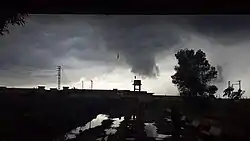
Migration
Due to extreme weather and uncertain economic outcomes, rural communities in Pakistan have been displaced in large numbers to major cities. Experts expect 20% of the population to move to major cities; current migration patterns included 700,000 people a year moving from rural to urban environments. Larger estimates, including major displacements because of extreme weather, suggest as many as 20 million migrants from rural to urban communities since 2010.[19]
Present and future Köppen-Geiger climate classification maps
Government action
Various programs focused on adaptation and mitigation have been developed within the Pakistani government. Since 2017, a cabinet-level ministry has led much of that capacity.
Ministry of Climate Change
The Ministry of Climate Change (Urdu: وزارتِ تغیّراتِ موسمیات; abbreviated as MoCC), is a Cabinet-level ministry of the Government of Pakistan concerned with climate change in Pakistan. The advisor to the Prime Minister, Malik Amin Aslam is in charge of the ministry with the status of a Federal Minister.[20] Zartaj Gul is the current Minister of State for Climate Change.
Prime Minister Imran Khan launched the Clean Green Pakistan Movement on 8 October 2018 to help create a clean and green environment of Pakistan.[21] The annual budget for the year 2018-2019 is 802.69 million rupees according to the PSDP Report.[22]
When coming into power, Prime Minister Imran Khan also launched the 10 Billion Tree Tsunami which aims at planting trees across the nation in a span of five years in hopes of reversing decades of deforestation.[23]Reforestation
Pakistan only has less than 6% forest area. This, combined with the climate changes, exacerbates challenges such as flooding, heat waves, and soil loss.[24] Starting in 2014, the government started pursuing a Billion Tree Tsunami policy, and in 2018 that policy was extend to a 10 billion tree, Plant for Pakistan program.[14] During the COVID-19 pandemic in Pakistan, government agencies continued their reforestation program planning to plant and creating 60,000 jobs among the unemployed.[24]
Public opinion
According to the BBC Climate Asia report,[4] the majority of the Pakistani people surveyed claimed that climate change has heavily impacted their lives in the form of floods and droughts, and most importantly has affected the availability of resources such as energy and water. 53% of Pakistanis felt that their lives had become worse off than they were five years ago. Although the effects of climate change are evident, the survey found that the majority of the people were unaware of the meaning of climate change, and "ascribed changes in climate and extreme weather events to the will of God."[4]
References
- Eckstein, David, et al. "Global climate risk index 2020." (PDF) Germanwatch (2019).
- "Pakistan crafts plan to cut carbon emissions 30% by 2025". The Express Tribune. 10 June 2015. Retrieved 10 June 2015.
- "Pakistan National Policy on Climate Change". Archived from the original on 2016-03-05. Retrieved 2015-05-10.
- Zaheer, Khadija; Colom, Anna. "Pakistan, How the people of Pakistan live with climate change and what communication can do" (PDF). www.bbc.co.uk/climateasia. BBC Media Action.
- Chaudhry, Qamar Uz Zaman (2017-08-24). Climate Change Profile of Pakistan. Asian Development Bank. doi:10.22617/tcs178761. ISBN 978-92-9257-721-6.
 Text was copied from this source, which is available under a Creative Commons Attribution 3.0 IGO (CC BY 3.0 IGO) license.
Text was copied from this source, which is available under a Creative Commons Attribution 3.0 IGO (CC BY 3.0 IGO) license. - World Bank. Development Indicators. Data for 2011. (accessed on 25 May 2015).
- Cubasch, U., D. Wuebbles, D. Chen, M.C. Facchini, D. Frame, N. Mahowald, and J.-G. Winther. (2013). Introduction. In: Climate Change 2013: The Physical Science Basis. Contribution of Working Group I to the Fifth Assessment Report of the Intergovernmental Panel on Climate Change (PDF) [Stocker, T.F., D. Qin, G.-K. Plattner, M. Tignor, S.K. Allen, J. Boschung, A. Nauels, Y. Xia, V. Bex and P.M. Midgley (eds.)]. Cambridge University Press, Cambridge, United Kingdom and New York, NY, USA.
- Hijioka, Y., E. Lin, J.J. Pereira, R.T. Corlett, X. Cui, G.E. Insarov, R.D. Lasco, E. Lindgren, and A. Surjan. (2014). Asia. In: Climate Change 2014: Impacts, Adaptation, and Vulnerability. Part B: Regional Aspects.Contribution of Working Group II to the Fifth Assessment Report of the Intergovernmental Panel on Climate Change (PDF) [Barros, V.R., C.B. Field, D.J. Dokken, M.D. Mastrandrea, K.J. Mach, T.E. Bilir, M. Chatterjee, K.L. Ebi, Y.O. Estrada, R.C. Genova, B. Girma, E.S. Kissel, A.N. Levy, S. MacCracken, P.R. Mastrandrea, and L.L. White (eds.)]. Cambridge University Press, Cambridge, United Kingdom and New York, NY, USA, pp. 1327-1370.
- The Global Economy. (2016). Country Ranking using Data on Carbon Dioxide Emissions Per Capita. (accessed on 28 Nov 2020).
- K. A. Mir and M. Ijaz. (2015). Greenhouse Gas Emissions Inventory of Pakistan for the Year 2011–2012. (PDF) GCISC-PR-19. Islamabad: Global Change Impact Studies Centre (GCISC).
- "Pakistan National Policy on Climate Change". Archived from the original on 2016-03-05. Retrieved 2015-05-10.
- "Pakistan National Policy on Climate Change". Archived from the original on 2016-03-05. Retrieved 2015-05-10.
- "Pakistan | UNDP Climate Change Adaptation". www.adaptation-undp.org. Retrieved 2020-11-25.
- "Pakistan's virus-idled workers hired to plant trees". www.aljazeera.com. Retrieved 2020-04-29.
- M. M. Rabbani et al. (2008). The Impact of Sea Level Rise on Pakistan’s Coastal Zones - In a Climate Change Scenario. (PDF) 2nd International Maritime Conference at Bahria University, Karach
- Rhein, M., S.R. Rintoul, S. Aoki, E. Campos, D. Chambers, R.A. Feely, S. Gulev, G.C. Johnson, S.A. Josey, A. Kostianoy, C. Mauritzen, D. Roemmich, L.D. Talley and F. Wang. (2013). Observations: Ocean. In: Climate Change 2013: The Physical Science Basis. Contribution of Working Group I to the Fifth Assessment Report of the Intergovernmental Panel on Climate Change [Stocker, T.F., D. Qin, G.-K. Plattner, M. Tignor, S.K. Allen, J. Boschung, A. Nauels, Y. Xia, V. Bex and P.M. Midgley (eds.)]. Cambridge University Press, Cambridge, United Kingdom and New York, NY, USA
- Global Facility for Disaster Reduction and Recovery. (2011). Climate Risk and Adaptation Country Profile. (PDF) Washington DC: World Bank.
- "Climate change triggers widespread Pakistan migration". www.aa.com.tr. Retrieved 2020-04-29.
- "Climate change triggers widespread Pakistan migration". www.aa.com.tr. Retrieved 2020-04-29.
- "MOCC Home Page". web.archive.org. 2020-11-25. Archived from the original on 2020-11-03. Retrieved 2020-11-25.
- "Clean Green Pakistan". cleangreen.gov.pk. Retrieved 2020-08-09.
- "Budget 2018-19: Govt allocates Rs 802 million for Climate Change Division". Profit by Pakistan Today. 2018-04-27. Retrieved 2019-02-23.
- "New leader of terror-torn Pakistan plans to plant 10 billion trees". NBC News. Retrieved 2019-02-23.
- "Pakistan's virus-idled workers hired to plant trees". www.aljazeera.com. Retrieved 2020-04-29.
External links
- A 5000-yr Record of Climate Change in Varved Sediments from the Oxygen Minimum Zone off Pakistan, Northeastern Arabian Sea
- Asian Developmental Bank Report on the Climate Change Profile of Pakistan
- Climate change in the Northwest Frontier Province of Pakistan
- Impact of climate change in Pakistan
- IPCC Report on Climate Change 2014: Impacts, Adaptation, and Vulnerability. Part B: Regional Aspects. Chapter 24: Asia
- Pakistan worst affected by climate change
- Climate change in Pakistan: innovation in the absence of government support
- "Global Warming impacts & Effects on The Climate of Pakistan" PakWeather.com February 28, 2015
